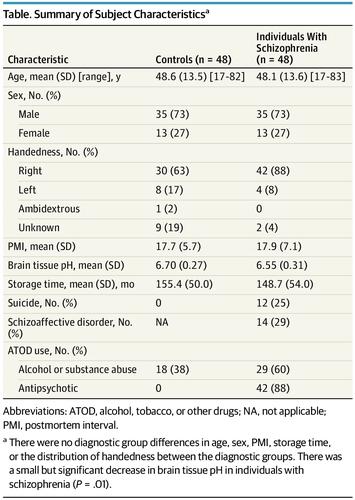JAMA Psychiatry ( IF 22.5 ) Pub Date : 2020-01-01 , DOI: 10.1001/jamapsychiatry.2019.2974 Matthew L MacDonald 1, 2 , Megan Garver 1 , Jason Newman 1 , Zhe Sun 3 , Joseph Kannarkat 1 , Ryan Salisbury 1 , Jill Glausier 1 , Ying Ding 3 , David A Lewis 1 , Nathan Yates 2 , Robert A Sweet 1

|
Importance Findings from unbiased genetic studies have consistently implicated synaptic protein networks in schizophrenia, but the molecular pathologic features within these networks and their contribution to the synaptic and circuit deficits thought to underlie disease symptoms remain unknown.
Objective To determine whether protein levels are altered within synapses from the primary auditory cortex (A1) of individuals with schizophrenia and, if so, whether these differences are restricted to the synapse or occur throughout the gray matter.
Design, Setting, and Participants This paired case-control study included tissue samples from individuals with schizophrenia obtained from the Allegheny County Office of the Medical Examiner. An independent panel of health care professionals made consensus DSM-IV diagnoses. Each tissue sample from an individual with schizophrenia was matched by sex, age, and postmortem interval with 1 sample from an unaffected control individual. Targeted mass spectrometry was used to measure protein levels in A1 gray matter homogenate and synaptosome preparations. All experimenters were blinded to diagnosis. Mass spectrometry data were collected from September 26 through November 4, 2016, and analyzed from November 3, 2016, to July 15, 2019.
Main Outcomes and Measures Primary measures were homogenate and synaptosome protein levels and their coregulation network features. Hypotheses generated before data collection were (1) that levels of canonical postsynaptic proteins in A1 synaptosome preparations would differ between individuals with schizophrenia and controls and (2) that these differences would not be explained by changes in total A1 homogenate protein levels.
Results Synaptosome and homogenate protein levels were investigated in 48 individuals with a schizophrenia diagnosis and 48 controls (mean age in both groups, 48 years [range, 17-83 years]); each group included 35 males (73%) and 13 females (27%). Robust alterations (statistical cutoff set at an adjusted Limma P < .05) were observed in synaptosome levels of canonical mitochondrial and postsynaptic proteins that were highly coregulated and not readily explained by postmortem interval, antipsychotic drug treatment, synaptosome yield, or underlying alterations in homogenate protein levels.
Conclusions and Relevance These findings suggest a robust and highly coordinated rearrangement of the synaptic proteome. In line with unbiased genetic findings, alterations in synaptic levels of postsynaptic proteins were identified, providing a road map to identify the specific cells and circuits that are impaired in individuals with schizophrenia A1.
中文翻译:

精神分裂症患者初级听觉皮层突触蛋白质组的改变。
公正的遗传学研究的重要发现始终表明突触蛋白网络与精神分裂症有关,但这些网络内的分子病理特征及其对被认为是疾病症状基础的突触和回路缺陷的贡献仍然未知。
目的确定精神分裂症患者初级听觉皮层 (A1) 突触内的蛋白质水平是否发生改变,如果改变,这些差异是否仅限于突触或发生在整个灰质中。
设计、设置和参与者这项配对病例对照研究包括从阿勒格尼县法医办公室获得的精神分裂症患者的组织样本。由医疗保健专业人士组成的独立小组就 DSM-IV 诊断达成了共识。精神分裂症患者的每个组织样本在性别、年龄和死后间隔方面均与未患病对照个体的 1 个样本进行匹配。使用靶向质谱法测量 A1 灰质匀浆和突触体制剂中的蛋白质水平。所有实验者都对诊断不知情。质谱数据于2016年9月26日至11月4日收集,并于2016年11月3日至2019年7月15日进行分析。
主要结果和措施主要措施是匀浆和突触体蛋白质水平及其共调节网络特征。数据收集之前产生的假设是(1)A1 突触体制剂中典型突触后蛋白的水平在精神分裂症患者和对照组之间存在差异;(2)这些差异不能用总 A1 匀浆蛋白水平的变化来解释。
结果对 48 名精神分裂症患者和 48 名对照者(两组平均年龄均为 48 岁 [范围,17-83 岁])的突触体和匀浆蛋白水平进行了研究;每组包括 35 名男性 (73%) 和 13 名女性 (27%)。在典型线粒体和突触后蛋白的突触体水平中观察到了稳健的改变(统计截止值设定为调整后的 Limma P < .05),这些改变是高度共同调节的,并且不易通过死后间隔、抗精神病药物治疗、突触体产量或潜在的改变来解释。匀浆蛋白质水平。
结论和相关性这些发现表明突触蛋白质组存在强大且高度协调的重排。根据公正的遗传发现,突触后蛋白的突触水平发生了变化,这为识别精神分裂症 A1 患者受损的特定细胞和回路提供了路线图。











































 京公网安备 11010802027423号
京公网安备 11010802027423号